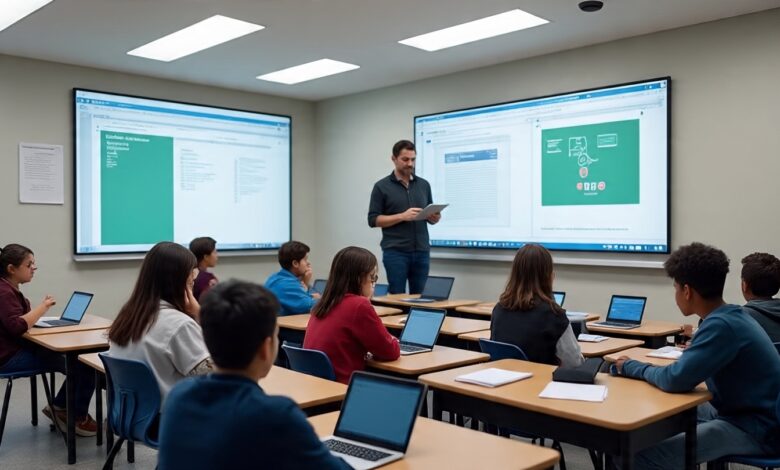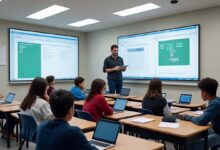
The educational landscape is experiencing a revolutionary transformation as the Internet of Things (IoT) emerges as a cornerstone technology reshaping how students learn and educators teach. IoT in education represents a paradigm shift from traditional classroom methodologies to interconnected, intelligent learning ecosystems that respond dynamically to individual needs and preferences. This technological revolution encompasses everything from smart learning solutions that adapt to student behavior to connected devices that create seamless educational experiences across physical and digital boundaries.
The integration of IoT technology in education has accelerated dramatically, with the global smart education market projected to reach $584 billion by 2025, growing at an impressive compound annual growth rate of 22.5%. This explosive growth reflects educators’ and institutions’ recognition that digital transformation in education is no longer optional but essential for preparing students for an increasingly connected world. Educational technology powered by IoT is creating unprecedented opportunities for personalized learning, real-time performance tracking, and enhanced classroom engagement.
Smart classrooms equipped with educational sensors, interactive displays, and connected learning devices are becoming the new standard, enabling educators to deliver more effective, engaging, and inclusive educational experiences. These intelligent learning environments leverage data analytics and automation to optimize everything from temperature and lighting to curriculum delivery and assessment methods. As we explore the multifaceted role of IoT in education, we’ll discover how these technologies are not merely enhancing traditional teaching methods but fundamentally reimagining what modern education can achieve in terms of accessibility, personalization, and effectiveness for learners of all backgrounds and abilities.
Understanding IoT in Educational Contexts
Defining IoT in Education
IoT in education refers to the integration of interconnected smart devices, sensors, and digital platforms that collect, analyze, and share data to enhance teaching and learning experiences. This comprehensive network includes everything from interactive whiteboards and educational sensors to wearable devices and smart building systems that create responsive learning environments. Educational IoT solutions enable real-time monitoring of student engagement, environmental conditions, and learning progress, providing educators with unprecedented insights into the educational process.
The foundation of IoT technology in education lies in its ability to create seamless connections between physical learning spaces and digital resources. Connected devices in education communicate through various protocols including Wi-Fi, Bluetooth, and specialized educational networks, forming an integrated ecosystem that supports both in-person and remote learning scenarios. This interconnectedness allows for continuous data collection and analysis, enabling personalized learning experiences that adapt to individual student needs and preferences.
Core Components of Educational IoT Systems
Smart learning solutions typically comprise several key components working in harmony. Educational sensors monitor environmental factors such as air quality, lighting, and noise levels to maintain optimal learning conditions. Interactive learning devices including tablets, smart boards, and voice-activated assistants, facilitate dynamic content delivery and student participation. Learning management systems (LMS) serve as central hubs, coordinating data flow between various connected classroom elements while providing analytics and reporting capabilities.
The infrastructure supporting IoT in education also includes cloud-based platforms that store and process vast amounts of educational data. These systems enable real-time learning analytics, allowing educators to make informed decisions about curriculum adjustments and individual student support needs. Digital classroom management tools integrate with these platforms to automate administrative tasks, track attendance, and facilitate communication between students, teachers, and parents.
Smart Classrooms: The Foundation of Connected Learning
Physical Environment Optimization
Smart classrooms represent the physical manifestation of IoT in education, creating environments that automatically adjust to enhance learning outcomes. Educational sensors continuously monitor temperature, humidity, lighting, and air quality, making real-time adjustments to maintain optimal conditions for concentration and comfort. These intelligent learning environments can detect occupancy levels and adjust heating, ventilation, and air conditioning systems accordingly, reducing energy consumption while maintaining ideal learning conditions.
Connected lighting systems in smart classrooms automatically adjust brightness and color temperature based on time of day, weather conditions, and specific learning activities. Research indicates that proper lighting can improve student focus by up to 23% and reduce eye strain during extended digital learning sessions. Smart building management systems coordinate these various environmental controls, creating cohesive learning spaces that support both traditional instruction and technology-enhanced activities.
Interactive Learning Technologies
The integration of interactive learning devices transforms passive learning environments into dynamic, engaging spaces where students actively participate in their education. Smart whiteboards and interactive displays enable multi-touch collaboration, allowing multiple students to interact simultaneously without interference. These educational technology tools support various learning styles through multimedia content delivery, including videos, animations, and interactive simulations.
Digital classroom solutions incorporate IoT-enabled devices such as student response systems, tablet computers, and augmented reality tools that provide immediate feedback and assessment capabilities. Real-time learning analytics generated by these devices help educators identify knowledge gaps and adjust instruction methods on-the-fly. The seamless integration of these technologies creates connected learning experiences that bridge physical and digital educational resources.
Personalized Learning Through IoT Technologies
Adaptive Learning Systems
IoT in education enables unprecedented levels of personalization through adaptive learning platforms that continuously analyze student performance and behavior patterns. Educational data analytics collected from various connected devices help create detailed learner profiles, identifying individual strengths, weaknesses, and learning preferences. Smart learning algorithms use this information to automatically adjust content difficulty, presentation format, and pacing to match each student’s optimal learning path.
Personalized education platforms powered by IoT technology can recommend specific resources, activities, and assessment methods based on real-time performance data. These systems consider factors such as time spent on tasks, error patterns, and engagement levels to provide customized learning experiences. Intelligent tutoring systems integrated with educational IoT solutions offer immediate feedback and support, helping students overcome challenges before they become significant obstacles to progress.
Student Behavior and Engagement Monitoring
Educational sensors and wearable devices provide valuable insights into student engagement and well-being throughout the learning process. Biometric monitoring through smartwatches and fitness trackers can detect stress levels, attention spans, and physical activity patterns, helping educators optimize lesson timing and intensity. Digital learning analytics identify when students are most receptive to new information and when they need breaks or alternative approaches.
IoT-enabled classroom management systems track participation patterns, collaboration effectiveness, and individual contribution levels during group activities. Smart learning solutions use this data to provide teachers with real-time feedback about class dynamics and individual student needs. This comprehensive monitoring approach supports inclusive education by ensuring that all students receive appropriate attention and support regardless of their learning style or background.
Enhanced Campus Management and Safety
Comprehensive Security Systems
IoT technology in education significantly enhances campus safety through integrated security systems that provide real-time monitoring and rapid response capabilities. Smart security cameras equipped with facial recognition and behavioral analysis can identify potential threats and automatically alert security personnel. Connected access control systems use smart cards or biometric authentication to manage building access while maintaining detailed logs of campus activities.
Emergency response systems leverage IoT networks to provide instant communication during crises, automatically locking doors, activating alarm systems, and coordinating with local emergency services. Mobile safety apps connected to campus IoT infrastructure allow students and staff to quickly report incidents or request assistance. These comprehensive security measures create safer learning environments while respecting privacy and maintaining the open, collaborative atmosphere essential for effective education.
Resource Management and Sustainability
Smart campus management systems optimize resource utilization through IoT-enabled monitoring of energy consumption, water usage, and waste management. Intelligent building systems automatically adjust lighting, heating, and cooling based on occupancy patterns and environmental conditions, reducing operational costs by up to 30%. Educational institutions implementing sustainable IoT solutions demonstrate environmental responsibility while redirecting cost savings toward educational programs and resources.
Asset tracking systems using RFID technology and IoT sensors help institutions manage valuable equipment such as computers, laboratory instruments, and library resources. Digital inventory management reduces theft, improves maintenance scheduling, and ensures resources are available when needed. Smart parking systems and transportation management solutions further optimize campus operations while reducing environmental impact.
Learning Analytics and Data-Driven Decision Making
Real-Time Performance Monitoring
Learning analytics platforms powered by IoT in education provide educators with comprehensive, real-time insights into student performance and learning patterns. Educational data collection from various sources including digital learning platforms, interactive devices, and assessment tools creates detailed pictures of individual and class-wide progress. Smart analytics dashboards present this information in actionable formats, enabling teachers to make informed instructional decisions immediately rather than waiting for traditional assessment results.
Predictive analytics capabilities identify students at risk of falling behind or dropping out before problems become severe. Machine learning algorithms analyze patterns in attendance, assignment completion, engagement levels, and performance trends to flag concerns early. This proactive approach to education allows for timely interventions and support services, significantly improving student success rates and retention.
Curriculum Optimization
Data-driven curriculum development leverages insights from educational IoT systems to continuously improve learning materials and instructional methods. Content effectiveness analytics track how students interact with different types of learning resources, identifying which materials generate the highest engagement and learning outcomes. Smart content recommendation systems suggest optimal sequencing and delivery methods for educational materials based on student performance data.
Professional development programs for educators benefit from IoT-generated insights about effective teaching practices and classroom management strategies. Collaborative platforms enable teachers to share successful approaches and learn from data-driven best practices. This continuous improvement cycle ensures that educational technology implementations deliver maximum value for both educators and students.
Accessibility and Inclusive Education Solutions
Assistive Technology Integration
IoT in education plays a crucial role in creating more inclusive learning environments through adaptive technologies that support students with diverse needs and abilities. Smart assistive devices including voice recognition systems, screen readers, and alternative input methods integrate seamlessly with educational IoT networks to provide personalized support. Connected hearing aids and visual assistance tools automatically adjust to classroom environments and synchronize with presentation systems.
Universal Design for Learning (UDL) principles guide the implementation of IoT accessibility solutions that benefit all students, not just those with specific needs. Flexible content delivery systems automatically provide multiple representation formats, including audio, visual, and tactile options. Smart captioning systems and real-time translation tools support students with hearing impairments or language barriers, ensuring equal access to educational content.
Language Learning and Cultural Support
Immersive language learning experiences leverage IoT technologies to create authentic communication environments within classrooms. Smart translation devices and cultural context systems provide real-time support for English Language Learners (ELLs) while preserving opportunities for authentic language practice. Connected cultural exchange programs use IoT-enabled communication tools to connect students with peers from different countries and backgrounds.
Multicultural education platforms incorporate IoT sensors and adaptive interfaces that adjust to different cultural learning preferences and communication styles. Digital storytelling tools and virtual reality experiences expose students to diverse perspectives and experiences, fostering global citizenship and cultural understanding. These inclusive technology solutions ensure that all students can participate fully in their educational journey regardless of their background or circumstances.
Remote Learning and Hybrid Education Models
Virtual Classroom Technologies
IoT-enabled remote learning solutions create engaging, interactive virtual classrooms that maintain the personal connection and collaborative elements essential for effective education. Smart webcams with automatic tracking and intelligent audio systems ensure clear communication between instructors and remote students. Virtual reality platforms and augmented reality tools provide immersive learning experiences that transcend physical classroom limitations.
Hybrid learning management systems seamlessly integrate IoT devices in physical classrooms with remote learning technologies, ensuring consistent experiences for all students regardless of their location. Real-time collaboration tools enable simultaneous participation from in-person and remote students in group projects and discussions. Digital whiteboard systems and shared workspace platforms maintain the interactive, collaborative nature of traditional classroom learning in virtual environments.
Bridging the Digital Divide
Educational equity initiatives leverage IoT technologies to address disparities in access to quality education resources. Mobile learning solutions including educational tablets and portable Wi-Fi hotspots ensure that students without reliable internet access can participate in digital learning programs. Community learning networks use IoT infrastructure to create local education hubs in underserved areas.
Offline-capable learning systems synchronize with educational IoT networks when connectivity is available, ensuring continuous learning opportunities even in areas with limited internet infrastructure. Adaptive bandwidth systems automatically adjust content quality and delivery methods based on available connection speeds. These inclusive technology approaches ensure that digital transformation in education benefits all students, regardless of their economic circumstances or geographic location.
Future Trends and Innovations in Educational IoT
Artificial Intelligence Integration
The convergence of artificial intelligence (AI) and IoT in education promises even more sophisticated and responsive learning environments. AI-powered educational assistants will provide 24/7 student support, answering questions, providing explanations, and offering personalized study recommendations. Intelligent content creation systems will automatically generate customized learning materials based on individual student needs and learning objectives.
Predictive learning analytics enhanced by AI algorithms will identify optimal learning conditions and predict future academic outcomes with unprecedented accuracy. Automated curriculum adjustment systems will continuously refine educational programs based on real-time performance data and emerging educational research. These next-generation educational technologies will create truly adaptive learning ecosystems that evolve continuously to meet changing student needs.
Emerging Technologies and Applications
Blockchain technology integration with educational IoT systems will provide secure, verifiable credentialing and achievement tracking that follows students throughout their educational journey. 5G networks will enable more sophisticated real-time learning applications including high-quality virtual reality experiences and instantaneous data synchronization across global educational networks.
Edge computing implementations will process educational data locally, reducing latency and improving privacy protection while maintaining the benefits of connected learning systems. Quantum computing applications may eventually revolutionize educational simulations and complex problem-solving exercises, providing students with access to computational resources previously reserved for advanced research institutions.
Implementation Challenges and Solutions
Privacy and Data Security Concerns
Educational data privacy remains a critical consideration in IoT in education implementations, requiring comprehensive policies and technical safeguards to protect student information. Encrypted communication protocols and secure data storage systems ensure that sensitive educational data remains protected from unauthorized access. Privacy-by-design principles guide the development of educational IoT solutions, minimizing data collection to essential information while maximizing educational benefits.
Student data governance frameworks establish clear policies for data collection, usage, and sharing, ensuring compliance with regulations such as FERPA and COPPA. Transparent consent systems inform students and parents about data collection practices and provide control over personal information sharing. Regular security audits and vulnerability assessments maintain the integrity of educational IoT networks while building trust with educational communities.
Infrastructure and Cost Considerations
Digital infrastructure development requires significant investment in network capacity, device procurement, and technical support systems. Phased implementation strategies help educational institutions gradually build IoT capabilities while managing costs and minimizing disruption to existing programs. Public-private partnerships and grant funding opportunities support educational technology adoption in resource-limited environments.
Training and professional development programs ensure that educators can effectively utilize IoT tools and smart learning solutions to enhance their teaching practices. Technical support systems and maintenance programs maintain educational IoT infrastructure while providing ongoing assistance to teachers and students. Cost-benefit analysis frameworks help institutions make informed decisions about technology investments and prioritize implementations that provide maximum educational value.
Measuring Success and ROI in Educational IoT
Key Performance Indicators
Educational outcomes measurement in IoT-enhanced learning environments requires comprehensive metrics that capture both academic achievement and engagement improvements. Student performance analytics track progress across multiple dimensions including knowledge retention, skill development, and critical thinking abilities. Engagement metrics from interactive learning systems provide insights into student motivation and participation levels.
Institutional efficiency indicators measure the operational benefits of smart campus systems including energy savings, resource utilization improvements, and administrative cost reductions. Teacher satisfaction surveys and professional development outcomes assess the impact of educational technology on educator effectiveness and job satisfaction. Long-term learning outcomes and career readiness metrics evaluate the broader impact of IoT-enhanced education on student success.
Return on Investment Analysis
Educational technology ROI calculations consider both quantitative and qualitative benefits of IoT in education implementations. Cost savings from improved energy efficiency, reduced administrative overhead, and optimized resource management provide measurable financial returns. Academic achievement improvements and increased graduation rates demonstrate the educational value of smart learning solutions.
Operational efficiency gains including reduced maintenance costs, improved asset utilization, and streamlined administrative processes, contribute to overall ROI. Grant funding success and partnership opportunities often result from successful educational IoT implementations, providing additional financial benefits. Competitive advantage in student recruitment and retention represents long-term value that extends beyond immediate cost considerations.
Conclusion
The integration of IoT in education represents a transformative force that is reshaping learning environments, enhancing educational outcomes, and preparing students for an increasingly connected world. Through smart learning solutions, connected classrooms, and intelligent educational systems, IoT technologies create personalized, engaging, and effective learning experiences that adapt to individual student needs while optimizing institutional operations. The implementation of educational IoT solutions demonstrates measurable improvements in student engagement, academic performance, and operational efficiency while supporting inclusive education practices that benefit learners of all backgrounds and abilities. As digital transformation in education continues to evolve, the strategic adoption of IoT technologies will be essential for educational institutions seeking to provide high-quality, accessible, and future-ready learning experiences that prepare students for success in our interconnected global society.











